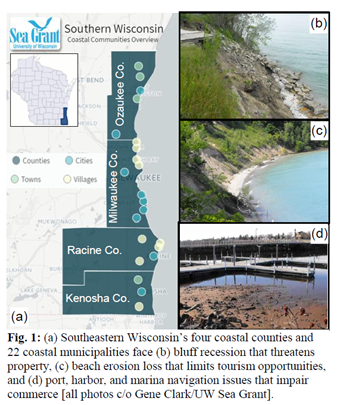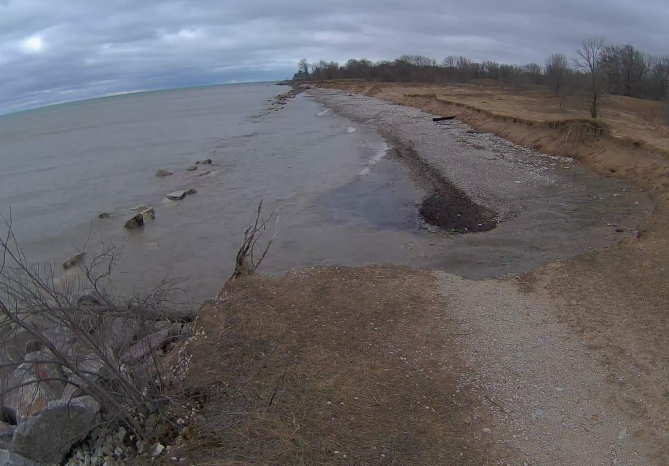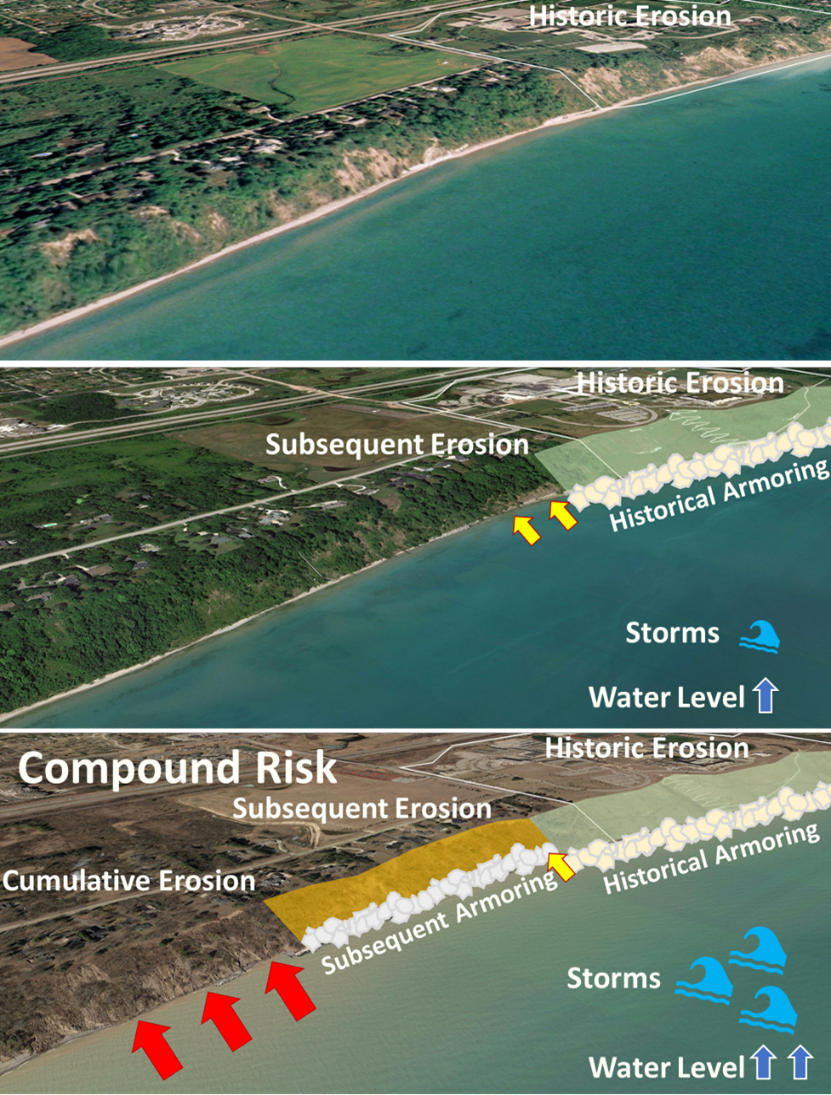Coastal Hazards
 The Lake Michigan coast of Southeastern Wisconsin is composed of bluffs, beaches, and waterfront port, harbor, and marina infrastructure. These interconnected coastal features serve as the interface between high-value upland areas and the economic and cultural assets of Lake Michigan. The function of these coastal features is impaired by climate and weather hazards, shoreline and bluff erosion, coastal storms including storm surges and waves, and lake water level fluctuations ranging over 6 feet. Bluff properties are at risk to bluff recession and slope failure, which are exacerbated by storms, high water levels, and changes in nearshore sediment transport. Beach economic and cultural value is threatened by erosion, which is intensified by storms and a loss of sand from the nearshore sediment system. Port, harbor, and marina economic use is threatened by large lake level changes that both impair navigation and accelerate infrastructure decay. As these features are interconnected through regional sediment transport, implementation of coastal protection and actions to reduce risk may have negative impacts to surrounding areas.
The Lake Michigan coast of Southeastern Wisconsin is composed of bluffs, beaches, and waterfront port, harbor, and marina infrastructure. These interconnected coastal features serve as the interface between high-value upland areas and the economic and cultural assets of Lake Michigan. The function of these coastal features is impaired by climate and weather hazards, shoreline and bluff erosion, coastal storms including storm surges and waves, and lake water level fluctuations ranging over 6 feet. Bluff properties are at risk to bluff recession and slope failure, which are exacerbated by storms, high water levels, and changes in nearshore sediment transport. Beach economic and cultural value is threatened by erosion, which is intensified by storms and a loss of sand from the nearshore sediment system. Port, harbor, and marina economic use is threatened by large lake level changes that both impair navigation and accelerate infrastructure decay. As these features are interconnected through regional sediment transport, implementation of coastal protection and actions to reduce risk may have negative impacts to surrounding areas.
Bluff erosion through waves, subsequent bluff slope destabilization, and eventual bluff failure are coastal hazards in Southeastern Wisconsin. The bluff hazard has been exacerbated recently due high Lake Michigan water levels which bring erosive waves higher on the bluff toe. This coastal hazard puts homes and properties in danger.
Impaired beach function due to water quality and erosion has led to economic losses in Southeastern Wisconsin. Although many beach restoration projects have focused on improving water quality, they often lack in considering beach erosion resilience. Beach erosionis exacerbated from armoring of the coast. Due to a multitude of possible and yet unknown future shore protection configurations, beach erosion losses can be difficult to predict and prevent.
Impairment to commercial ports, harbors, marinas, and navigation channels can negatively impact the economic security of Wisconsin. Low water levels & sediment deposition impair navigation, requiring costly dredging. Low water levels also expose timber and rock infrastructure to air that accelerates deterioration while high water levels and storm-induced waves can reduce infrastructure stability and strength.
Bluffs, beaches, and waterfront infrastructure are interconnected through regional sediment transport and nearshore processes. The interconnected bluff, beach, and infrastructure can mean local actions may lead to unintended issues and risks regionally. Increased erosion near armoring or loss of sediment near dredged areas are examples of complex impacts unintended from local projects. To enhance coastal resilience in Southeastern Wisconsin, coastal hazards need to be understood and addressed. The Coastal Actions for Resilience and Economic Security (CARES) Project of Southeastern Wisconsin Bluff, Beach, and Infrastructure Assets works to address this through increasing awareness of risks, hazards and impacts from differing coastal protection structure types in Southeastern Wisconsin along the coast of Lake Michigan.
Loss of Ecological Health and Degraded Coastal Habitats
 Southeastern Wisconsin Lake Michigan shoreline is severely threatened by the loss of ecological health and aquatic biodiversity due to degraded habitats of fish and wildlife in dune and beach systems, one of the critical resilience hubs in the Great Lakes. In particular, this stretch of Wisconsin shoreline was reported as the most critical reach of the entire Lake Michigan coast in terms of shore damage and recession rates. Numerous man-made engineering coastal structures (shore-parallel revetments, shore-perpendicular groins, and storm wave-dissipating breakwaters) were constructed to stabilize sediment and prevent erosion of the urban shoreline in Milwaukee, Racine, and Kenosha Counties. Recent studies suggest that shoreline hardening could affect ecological consequences like the habitat value and biodiversity (richness or diversity), possibly by interrupting the connection between land and water, downcutting lakebed sediment, and altering the pathway of long-shore and cross-shore sediment transport. Since 2014, several extreme storms and the rising lake level in Lake Michigan have damaged deteriorating coastal structures, resulting in significant erosion of dunes and beaches on the southeastern Wisconsin shoreline. For example, Figure shows Kenosha Dunes State Natural Area has experienced severe erosion up to 80 ft along the 600 ft fallen revetments due to extreme storm events on the high water levels during the last three years. The eroded public trail no longer provides safe public access the function. Many rare and endangered species of plants and wildlife are threatened. The inappropriate partial shoreline hardening accelerated the beach erosion. Identified in Wisconsin Coastal Communities Working Group, Wisconsin Coastal Management Program, Needs Assessment & Strategy, and Wisconsin Emerge Management State Hazard Mitigation Plan (WEM, 2016), many dune and beach systems of southeastern Wisconsin Lake Michigan shoreline are vulnerable to severe erosion caused by growing degraded engineering protection structures (High Risk), weather-induced hazards like intensified storm surges and extreme waves (High to Moderate Risk), and fluctuating lake water levels over a range of 6 feet (High to Moderate Risk). The proposed project calls for innovative approaches of natural infrastructure and ongoing risk-reduction efforts for Restoring Ecological Health and Aquatic Biodiversity (REHAB) of degraded dune and beach systems that would benefit coastal community resilience and fish and wildlife of southeastern Wisconsin Lake Michigan.
Southeastern Wisconsin Lake Michigan shoreline is severely threatened by the loss of ecological health and aquatic biodiversity due to degraded habitats of fish and wildlife in dune and beach systems, one of the critical resilience hubs in the Great Lakes. In particular, this stretch of Wisconsin shoreline was reported as the most critical reach of the entire Lake Michigan coast in terms of shore damage and recession rates. Numerous man-made engineering coastal structures (shore-parallel revetments, shore-perpendicular groins, and storm wave-dissipating breakwaters) were constructed to stabilize sediment and prevent erosion of the urban shoreline in Milwaukee, Racine, and Kenosha Counties. Recent studies suggest that shoreline hardening could affect ecological consequences like the habitat value and biodiversity (richness or diversity), possibly by interrupting the connection between land and water, downcutting lakebed sediment, and altering the pathway of long-shore and cross-shore sediment transport. Since 2014, several extreme storms and the rising lake level in Lake Michigan have damaged deteriorating coastal structures, resulting in significant erosion of dunes and beaches on the southeastern Wisconsin shoreline. For example, Figure shows Kenosha Dunes State Natural Area has experienced severe erosion up to 80 ft along the 600 ft fallen revetments due to extreme storm events on the high water levels during the last three years. The eroded public trail no longer provides safe public access the function. Many rare and endangered species of plants and wildlife are threatened. The inappropriate partial shoreline hardening accelerated the beach erosion. Identified in Wisconsin Coastal Communities Working Group, Wisconsin Coastal Management Program, Needs Assessment & Strategy, and Wisconsin Emerge Management State Hazard Mitigation Plan (WEM, 2016), many dune and beach systems of southeastern Wisconsin Lake Michigan shoreline are vulnerable to severe erosion caused by growing degraded engineering protection structures (High Risk), weather-induced hazards like intensified storm surges and extreme waves (High to Moderate Risk), and fluctuating lake water levels over a range of 6 feet (High to Moderate Risk). The proposed project calls for innovative approaches of natural infrastructure and ongoing risk-reduction efforts for Restoring Ecological Health and Aquatic Biodiversity (REHAB) of degraded dune and beach systems that would benefit coastal community resilience and fish and wildlife of southeastern Wisconsin Lake Michigan.
Cumulative Impacts and Coastal Changes
 The cumulative impacts of coastal erosion are influenced by a cascade of drivers compounding in space and time that have physical, social, and community ramifications. Risk to coastal communities caused by increasingly intense physical changes threaten people, their livelihoods, and environmental health. Coastal erosion costs the U.S. over $500 million in damages, over $150 million in infrastructure and over 80,000 acres of wetlands every year. In the Great Lakes, fluctuating water levels and more intense storms have created a physical environment that appears to be consuming the shoreline. Erosion of coastal assets such as bluffs and dunes can be observed at the bottom (toe) up to the top (crest), often nearby human infrastructure, namely people 's homes. The current practice to defend against this perceived threat is armoring the shore with conventional building materials, which have been shown to adversely affect neighboring properties. The cumulative impacts of these structures under fluctuating water levels and more intense storm waves have yet to be quantified. Additionally, indirect risks – such as elevated erosion occurring on properties adjacent to coastal structures – associated with coastal bluff erosion have not been comprehensively characterized. Furthermore, the role of local and global decision-makers has not been integrated with an analysis of the physical drivers to coastal erosion. These gaps in knowledge pose social, economic and environmental challenges that fuel community conflict, incur heavy costs, and jeopardize local and regional ecosystems.
The cumulative impacts of coastal erosion are influenced by a cascade of drivers compounding in space and time that have physical, social, and community ramifications. Risk to coastal communities caused by increasingly intense physical changes threaten people, their livelihoods, and environmental health. Coastal erosion costs the U.S. over $500 million in damages, over $150 million in infrastructure and over 80,000 acres of wetlands every year. In the Great Lakes, fluctuating water levels and more intense storms have created a physical environment that appears to be consuming the shoreline. Erosion of coastal assets such as bluffs and dunes can be observed at the bottom (toe) up to the top (crest), often nearby human infrastructure, namely people 's homes. The current practice to defend against this perceived threat is armoring the shore with conventional building materials, which have been shown to adversely affect neighboring properties. The cumulative impacts of these structures under fluctuating water levels and more intense storm waves have yet to be quantified. Additionally, indirect risks – such as elevated erosion occurring on properties adjacent to coastal structures – associated with coastal bluff erosion have not been comprehensively characterized. Furthermore, the role of local and global decision-makers has not been integrated with an analysis of the physical drivers to coastal erosion. These gaps in knowledge pose social, economic and environmental challenges that fuel community conflict, incur heavy costs, and jeopardize local and regional ecosystems.
A resilient coast tackles these gaps through a transdisciplinary approach of characterizing and responding to the compound risks linked to cumulative coastal erosion. Sustainable shore protection with Nature-Based Coastal Solutions integrated with the human dimension is a missing link in traditional coastal management practice. Southeastern Wisconsin experiences accelerated rates of bluff erosion under historically high-water levels and increased levels of human-development. As bluffs become less stable, the need for comprehensive sustainable shore protection that addresses the cumulative impacts of coastal erosion becomes more pressing.
